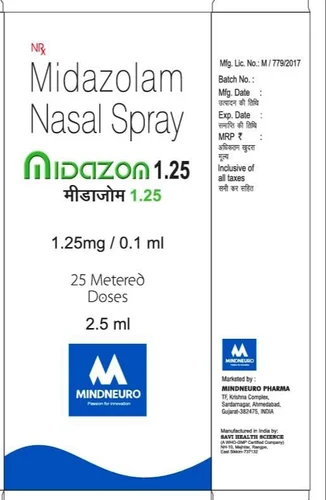💊 Midazolam Nasal Spray 1.25 mg/actuation
📌 1. Prescription / Indications:
Midazolam 1.25 mg per actuation nasal spray is typically prescribed for:
- Acute treatment of intermittent, prolonged, or cluster seizures in patients with epilepsy aged 12 years and above
- Also used off-label for:
- Acute seizure control in children (lower weight-adjusted doses)
- Procedural sedation or premedication (under medical supervision)
📄 2. Description:
- Form: Nasal spray (metered-dose)
- Strength: Each spray (actuation) delivers 1.25 mg of midazolam
- Total content: Usually comes in multi-dose nasal devices (e.g. 5 mg in 4 sprays, 10 mg in 8 sprays, etc.)
- Route: Intranasal (absorbed via nasal mucosa)
🔬 3. Nature / Drug Class:
- Class: Benzodiazepine
- Mechanism of Action:
Binds to GABA-A receptors, enhancing GABAergic transmission → CNS depression
→ Anticonvulsant, sedative, anxiolytic, and muscle relaxant effects
🌟 4. Advantages:
- Needle-free, fast-acting alternative to IV or IM benzodiazepines
- Rapid absorption via nasal mucosa (onset within 5–10 minutes)
- Easier and more socially acceptable than rectal diazepam
- Useful in home and emergency settings
📦 5. Common Packaging:
| Packaging Form | Details |
|---|
| Metered-dose nasal spray | Multi-dose unit, 1.25 mg per spray |
| Example: 5 mg bottle | Delivers 4 sprays of 1.25 mg each |
🧊 6. Storage Conditions:
- Store at 20–25°C (68–77°F)
- Avoid freezing or excessive heat
- Keep container tightly closed
- Store out of reach of children (Schedule IV controlled drug)
- Do not use if solution changes color or shows particles
👩⚕️ 7. Patient Advice:
- Use only during a seizure emergency, as directed
- Administer one spray into one nostril; do not alternate unless told
- Do not administer more than prescribed
- Seek emergency help if:
- Seizure lasts >10 minutes after spraying
- Breathing problems occur
- More than 2 seizures occur close together
- Caregivers should be trained in administration
- Patient should rest and not drive or operate machinery after use
🎯 8. Purpose / Clinical Use:
| Use | Purpose |
|---|
| Acute seizure management | Interrupts prolonged or cluster seizures |
| Home emergency treatment | Prevents progression to status epilepticus |
| Hospital/emergency setting | For rapid anticonvulsant action |
⚠️ 9. Warnings / Precautions:
- May cause:
- Sedation, drowsiness, respiratory depression
- Hypotension, amnesia, or paradoxical reactions (rare)
- Caution in:
- Respiratory disorders (asthma, COPD)
- Liver/kidney dysfunction
- Sleep apnea
- Do not combine with:
- Alcohol
- Other CNS depressants
- Risk of tolerance or withdrawal symptoms with repeated use

